Classic Creamy Oyster Stew: An Easy, Hearty, and Traditional Recipe
Oyster Stew is the epitome of comfort food, a cherished culinary classic that promises warmth and satisfaction in every spoonful. This exquisite dish features succulent, tender oysters gently simmered in a rich, velvety broth, generously infused with butter and milk. With its delicate balance of sweet and briny flavors, derived from fresh oysters and just a handful of simple ingredients, this stew is a testament to understated elegance. It’s an ideal choice for a cozy winter meal, offering hearty nourishment, or as a distinguished centerpiece for special occasions like Christmas Eve.

For me, this classic Oyster Stew recipe isn’t just a meal; it’s a cherished portal to a flood of treasured family memories. Every Christmas Eve, our final, most anticipated stop was always at my Grandpa and Grandma Martin’s house. It was a tradition deeply etched in the fabric of our holidays, centered around a steaming pot of oyster stew. What made it even more special was that they would patiently wait for my arrival, largely because my uncles reveled in their annual attempt to “scare” me with a raw oyster – an endeavor they consistently failed at! Year after year, we’d gather, slurp down briny raw oysters, and I’d be given the important task of helping prepare the oyster soup. This heartwarming ritual became a cornerstone of my Christmas Eves, a tradition I’ve lovingly carried forward into my own adult life, eager to share its magic with new generations.

This precious photograph, taken in 1985, captures a moment of pure joy in my grandparents’ kitchen as I savored my oyster. The memory of that day remains incredibly vivid and dear to my heart. Today, when I prepare this homemade oyster stew, a new iteration of the tradition has emerged: those who are willing pose for a photo with their raw oyster, and I promptly text these snapshots to my dad and uncles. It’s a small but significant way to keep the spirit of those festive Christmas Eves alive, connecting past and present through shared laughter and a beloved family recipe.
While you’re here exploring comforting and hearty meals, be sure to check out these other fantastic stew recipes: Mulligan Stew, Taco Stew, and Rustic Harvest Stew. Each offers a unique flavor profile perfect for any meal.
The Enduring Christmas Eve Tradition of Oyster Stew
The practice of serving oyster stew on Christmas Eve is a tradition rich with historical and cultural significance, extending far beyond simply enjoying a delicious meal. Oysters, once considered a luxurious delicacy, lent an air of sophistication and indulgence to the holiday feast, making the occasion feel truly special. This custom found its roots deep within Irish Catholic communities, eventually spreading throughout mainstream America.
During a time when Catholic fasting restrictions mandated abstaining from meat on Christmas Eve, oyster stew emerged as a perfect culinary solution. Not only did it provide a deeply satisfying, protein-rich dish, but oysters were also remarkably abundant and one of the few fresh food options readily available during the colder winter months. This seasonal availability, combined with religious observance, cemented the oyster’s role in holiday dining.
Beyond its practicality and luxurious appeal, the dish carries immense nostalgic and sentimental value. For many families, preparing and sharing oyster stew has become a cherished annual ritual, a tangible link to ancestral customs and treasured memories. It’s this profound sense of history, tradition, and familial connection that ensures the beloved practice of enjoying oyster stew on Christmas Eve continues to thrive, passed down through generations as a culinary testament to heritage and togetherness.

Crafting the Perfect Classic Oyster Stew
Oyster stew stands as a truly timeless dish, revered for its exquisitely velvety texture and the delicate, briny essence of fresh oyster flavor that permeates every spoonful. While many stews traditionally demand lengthy simmering times to develop their rich profiles, this particular creamy oyster stew recipe defies expectations. It delivers a deeply satisfying, soul-warming meal in under 30 minutes, making it an ideal choice for a quick yet luxurious dinner on a chilly winter day. My mother often prepared oyster stew during Lent, and its meatless, yet utterly fulfilling nature, makes it perfectly suited for such periods of abstinence, offering both comfort and flavor without compromise.
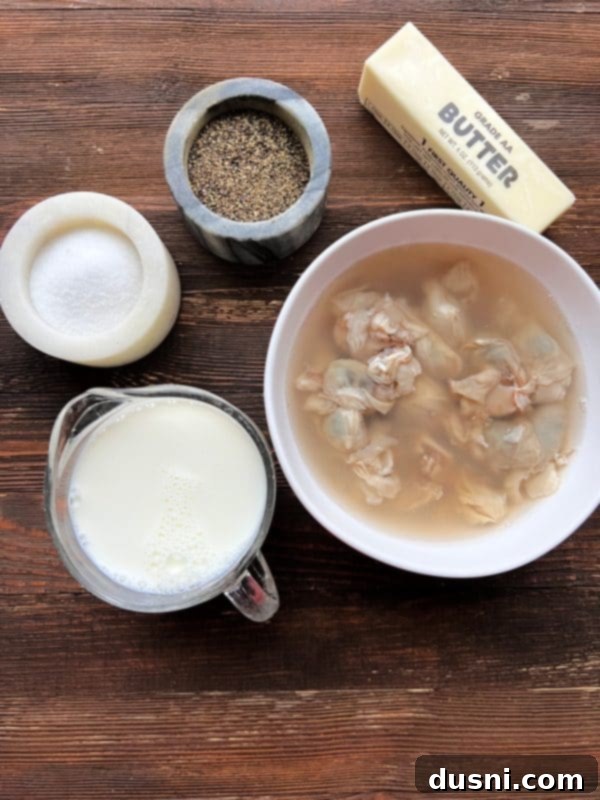
Essential Ingredients for Homemade Oyster Stew
The full list of ingredients and detailed instructions are conveniently located in the printable recipe card at the very bottom of this post. To create this remarkably easy and flavorful oyster stew, you’ll need just a few key components:
- Fresh Raw Oysters: These are the star of the show! Be sure to include the precious liquid they come in, also known as oyster liquor. I highly recommend purchasing raw, shucked oysters from the seafood counter at your local grocery store for the freshest flavor. However, I understand that fresh oysters aren’t always readily available, so I’ve included instructions later in this guide for successfully using canned oysters if that’s what you have on hand. The quality of your oysters directly impacts the final taste, so choose wisely.
- Butter: For this recipe, I advocate for a generous amount of high-quality salted butter. Butter is crucial not only for its rich flavor but also for creating the luxurious, silky texture of the stew. It helps to carry and enhance the delicate oyster notes.
- Whole Milk: Whole milk provides the foundational creamy base for the stew. For an even richer, more decadent result, you can easily substitute heavy cream or a half-and-half mixture. If you opt for skim milk or a lower-fat alternative, be aware that it will significantly alter both the taste and the desired thick, velvety consistency of the stew, making it much lighter.
- Salt and Black Pepper: These essential seasonings are added to taste. It’s important to season gradually and taste as you go, allowing the natural sweetness and brininess of the oysters to shine through, adjusting the saltiness to your preference.
- Oyster Crackers: No oyster stew experience is complete without a generous serving of oyster crackers or even classic saltine crackers. These provide a delightful textural contrast and are perfect for soaking up the delicious, buttery broth. Ensure you have plenty on hand for serving!
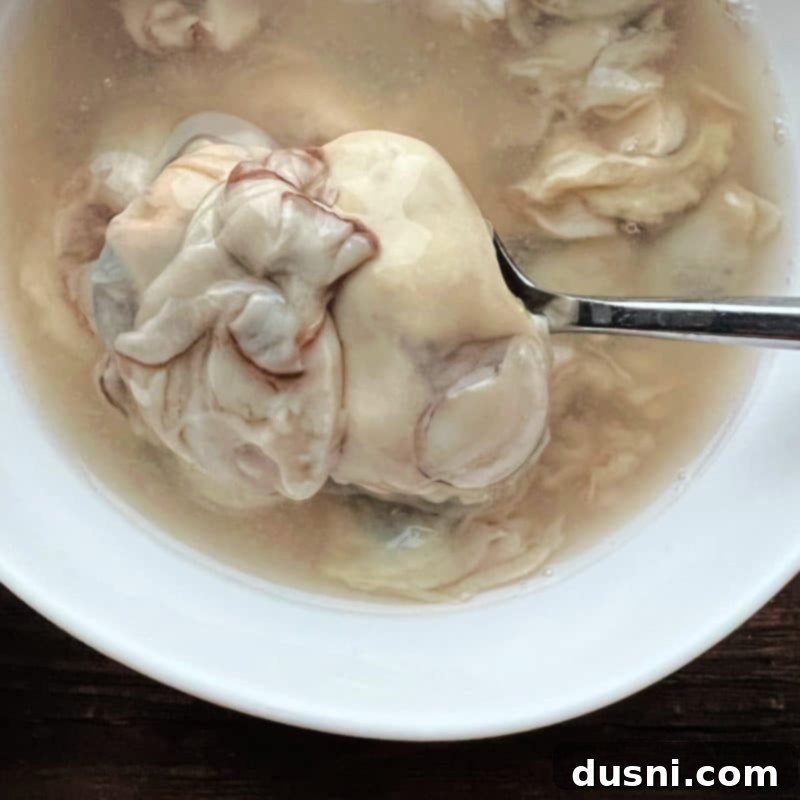
The use of fresh, plump, shucked oysters, along with their natural liquor, is paramount, as they infuse the broth with an unparalleled depth of essential briny flavor. Combined with whole milk or heavy cream, which contributes a wonderfully rich and comforting texture, these ingredients lay the foundation for an unforgettable culinary experience.
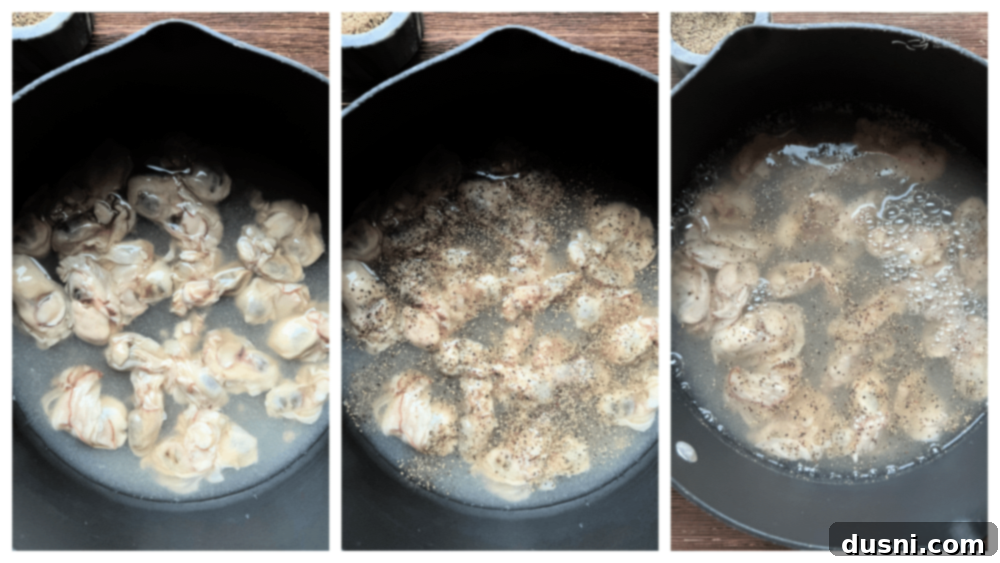
Step-by-Step Guide: How to Make the Best Oyster Stew
Creating a truly exceptional oyster stew is simpler than you might imagine, and achieving that perfect balance of tender oysters and a creamy, flavorful broth is all about careful execution and timing. Here’s how to make a classic oyster stew that will impress:
- Prepare the Oysters: Begin by adding your fresh oysters, along with all of their flavorful liquid (often called oyster liquor), to a large saucepan or a sturdy Dutch oven. This liquor is crucial for developing the stew’s signature briny depth.
- Season and Cover: Lightly sprinkle the oysters with salt and black pepper. Then, pour in just enough water to barely cover the oysters. This ensures they cook evenly and gently.
- Gentle Simmer: Place a lid on the pan and cook over medium heat. It’s important to monitor the oysters frequently, giving them a gentle stir occasionally. The key indicator that the oysters are done is when their edges just begin to curl. This signifies they are perfectly cooked through without becoming tough or rubbery.
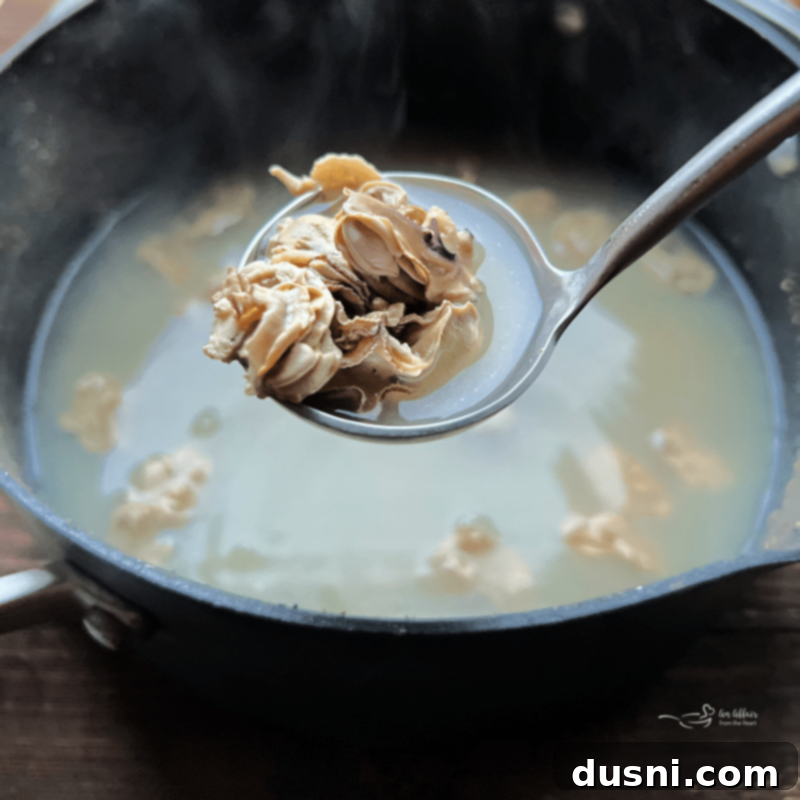
Note on Cooking Oysters: Exercise caution to avoid overcooking the oysters. They cook very quickly, and excessive heat or prolonged cooking will render them tough and chewy, detracting from their delicate texture. Aim for just a brief curl at the edges to ensure they are cooked through yet remain deliciously tender. This precision is what elevates a good oyster stew to a great one.
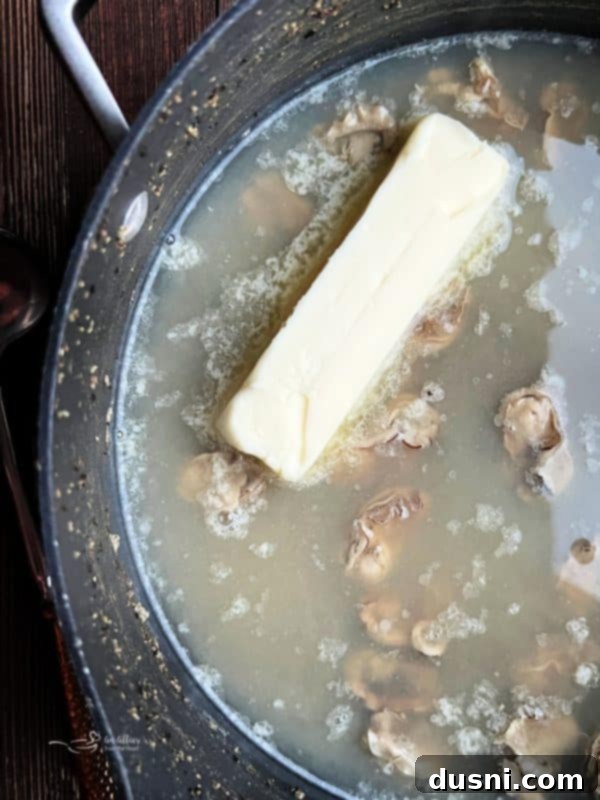
- Incorporate Butter: Once the oysters are perfectly cooked, add the butter to the saucepan. The butter will melt into the oyster-infused liquid, creating a rich, luscious base for your stew.

- Add Milk and Finish: Next, pour in the milk. Reduce the heat to medium-low immediately. Gently heat the mixture until the butter has fully melted and the stew is warmed through, but be very careful not to scald the milk. You want a gentle simmer, not a boil. Once the butter is melted, your oyster stew is essentially done. Taste the stew and adjust the seasoning as needed, adding more salt, pepper, or even a touch more butter if you feel it needs it.
Expert Tip on Butter: Sometimes, after tasting, I find the stew benefits from a little extra butter. The precise amount can vary slightly depending on the oysters’ brininess or the richness of the milk. Trust your palate and add more if you desire an even more indulgent, buttery finish. Use your discretion to achieve your perfect flavor balance.
Serve your oyster stew immediately, piping hot, alongside plenty of oyster crackers for a satisfying crunch. Leftover oyster stew can be safely stored in an airtight container in the refrigerator for 2-3 days. When reheating, do so gently on the stovetop over low heat to prevent the oysters from toughening and the milk from scorching. Many find that the flavors deepen and meld even more beautifully on the second day. However, I generally do not recommend freezing this soup, as the delicate texture of both the oysters and the dairy components can suffer significantly upon thawing.

Love This Recipe? Pin It for Later!
Don’t let this incredible Homemade Oyster Stew Recipe slip away! Be sure to Pin it to your favorite Pinterest board before you navigate away. This way, you’ll always have this comforting classic at your fingertips whenever the craving strikes!
Serving Suggestions to Complement Your Oyster Stew
Oyster stew is undeniably a complete and satisfying meal on its own, its richness and depth requiring little accompaniment. However, if you’re looking to transform it into a more substantial and elaborate meal, pairing it with a few simple sides can elevate the dining experience. Consider serving it with a crisp, refreshing side salad, dressed with a light vinaigrette, to cut through the richness of the stew. A freshly baked, crusty French baguette or a loaf of sourdough bread is an absolute must, perfect for dipping into the creamy, buttery broth and savoring every last drop. The crunchy crust provides a wonderful textural contrast to the smooth, tender oysters. For an even more festive touch, you might add a side of roasted asparagus or delicate green beans to complete your hearty and elegant meal. A glass of crisp white wine, such as a Sauvignon Blanc or Pinot Grigio, would also beautifully complement the briny notes of the oysters.
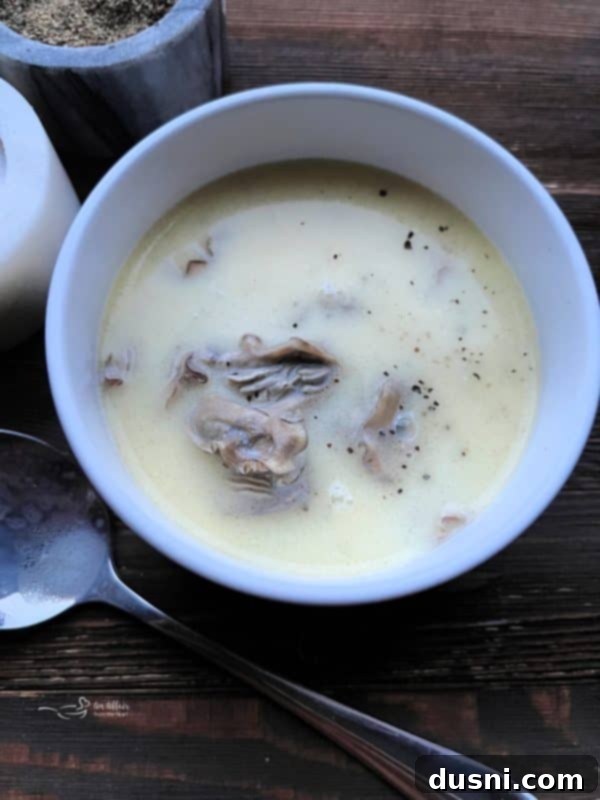
Oyster Stew: Tips, Creative Substitutions, & Delicious Additions
This versatile oyster stew recipe is incredibly adaptable, allowing for personal touches and dietary adjustments while maintaining its core comforting essence. Here are some tips and ideas to make your stew truly your own:
- Oyster Quality is Key: Always prioritize the freshest oysters available. If possible, seek them out from a reputable local seafood market. Freshness directly translates to superior flavor and texture in your stew.
- Boost the Flavor Profile: For those who appreciate a bit of heat, a dash of hot sauce or a pinch of red pepper flakes can introduce a subtle spicy kick. Alternatively, a squeeze of fresh lemon juice just before serving can brighten the briny flavor of the oysters and add a refreshing zing.
- Dairy Flexibility: While whole milk provides a rich base, feel free to experiment with half-and-half or a luxurious mix of heavy cream and milk for an even more decadent consistency. For a truly rich experience, some even opt for all heavy cream.
- Elegant Garnishes: Elevate the presentation and add an extra layer of freshness by garnishing individual bowls with finely chopped fresh herbs like parsley, chives, or dill. Thinly sliced green onions also provide a lovely color and a mild, piquant flavor.
- Add Heartiness and Depth: To make the stew more substantial, consider adding some pre-cooked chunks of potatoes, which will absorb the flavorful broth beautifully. For a classic seafood seasoning, a sprinkle of Old Bay Seasoning can introduce a fantastic, complex layer of flavor that complements the oysters perfectly.
- A Touch of Sherry: For a sophisticated twist and added depth, a tablespoon or two of dry sherry or white wine can be stirred in at the very end. This enhances the seafood flavors without overpowering them.
This adaptable oyster stew works wonderfully for any occasion, transitioning seamlessly from casual family dinners on a chilly evening to elegant holiday meals and festive gatherings. Its quick preparation and comforting nature make it an indispensable recipe for your culinary repertoire.
Can Canned Oysters Be Used in This Oyster Stew Recipe?
Absolutely! The beauty of this oyster stew recipe lies in its flexibility. My own mother successfully made this oyster stew with canned oysters for many years, proving that you don’t always need fresh seafood to enjoy this comforting dish. She would follow the same steps outlined in this recipe, simply using jarred or canned oysters in their natural juices. This was often her preferred method because canned oysters were not only more economical but also much more readily available in our area, especially when fresh options were scarce. While fresh oysters offer a distinct texture and brininess, canned oysters can still yield a wonderfully flavorful and satisfying stew. Just be sure to use the liquid they come in, as it contributes significantly to the broth’s depth.
Frequently Asked Questions (FAQs) About Oyster Stew
Here are some common questions about making and enjoying oyster stew:
- What type of oyster works best for stew? Any fresh raw oyster will work wonderfully, but certain varieties lend themselves particularly well to stew. Popular choices include Blue Point, Malpeque, or Kumamoto. Generally, larger oysters tend to hold up better in a stew, retaining their plump texture without disintegrating. However, the most important factor is freshness, regardless of the specific variety.
- Is oyster stew supposed to be thick? Traditional oyster stew is characterized by a creamy, yet relatively thin and brothy consistency, not a thick, heavy gravy. The natural starches released by the oysters during cooking, combined with the milk, create a slight, natural thickening without the need for flour or cornstarch. If you prefer a slightly thicker stew, you could consider adding a very small amount of cornstarch slurry (cornstarch mixed with a little cold water) at the end, but it’s not traditional.
- How do you store and reheat leftovers? To maintain its quality, refrigerate any leftover oyster stew promptly in an airtight container. It will keep well for up to 3 days. When reheating, it’s crucial to do so gently to prevent the oysters from toughening and the milk from scorching. The best method is to reheat it slowly on the stovetop over low heat, stirring frequently, until warmed through. Avoid high heat or vigorous boiling.
- Can I make oyster stew ahead of time? While oyster stew is best enjoyed fresh, it can be prepared a few hours in advance and gently reheated. For optimal results, cook the oysters and broth, then add the milk and butter just before serving to ensure the freshest flavor and texture. Oysters can toughen if left in hot liquid for too long.
- Is oyster stew gluten-free? Yes, this classic oyster stew recipe is naturally gluten-free, as it does not use any flour or thickeners containing gluten. Always check your oyster crackers if you are serving them, as some brands may contain gluten.
- Can I make a dairy-free oyster stew? While the traditional recipe relies heavily on dairy for its creamy texture, you could experiment with dairy-free milk alternatives like full-fat coconut milk or a rich oat milk. Be aware that these substitutions will alter the flavor profile significantly, introducing new notes that depart from the classic taste.
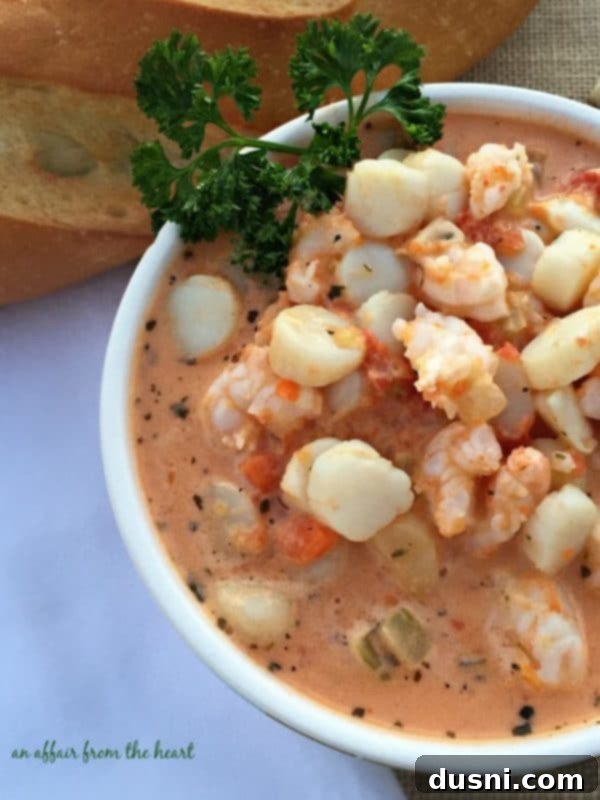
More Delicious Seafood & Soup Recipes to Love
If you’ve enjoyed this comforting oyster stew, you’ll be thrilled to explore more of my delightful seafood and soup creations. You can find ALL of my Seafood Recipes Here. Below are a few of my absolute favorites, perfect for expanding your culinary repertoire:
- Creamy Tomato Seafood Bisque (pictured above) – A luxurious and flavorful bisque that’s surprisingly easy to make.
- Shrimp & Crab Pasta – A light yet satisfying pasta dish bursting with fresh seafood flavors.
- Instant Pot New England Clam Chowder – Get that classic clam chowder taste in a fraction of the time.
- Mom’s Tuna Tetrazzini – A nostalgic and comforting casserole that’s a true family favorite.
- How to Smoke Salmon – Master the art of smoking salmon for an incredibly delicious treat.
- Crab Rangoon Dip – All the flavors of your favorite appetizer in a fun, dippable form.
And for even more soul-warming goodness, don’t forget to explore ALL of my Soup Recipes. There’s a perfect soup for every season and every craving!
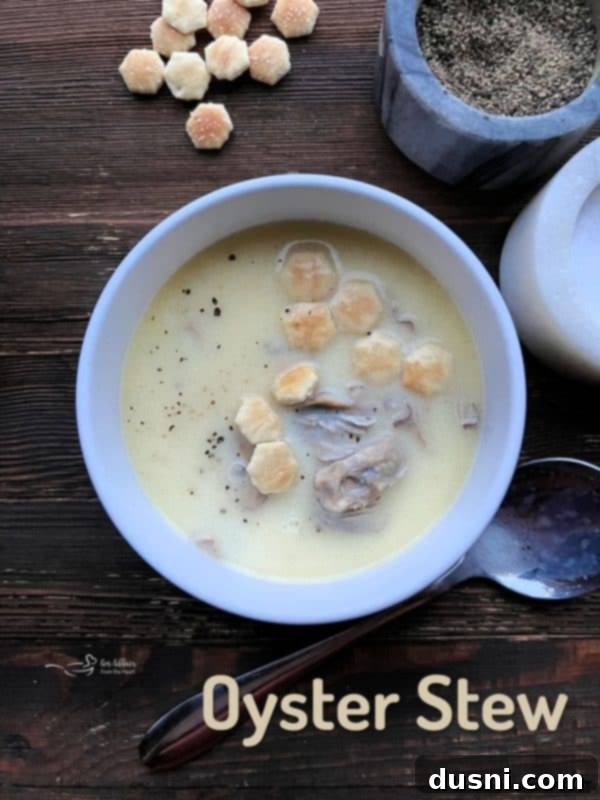
I sincerely hope that this treasured recipe for Classic Creamy Oyster Stew not only brings delightful flavors to your table but also inspires a long and beautiful tradition filled with warmth, family, and unforgettable memories in your home. May it become a dish you return to year after year, creating new stories with every comforting bowl.

LIKE THIS RECIPE?
Don’t forget to give it a ⭐️⭐️⭐️⭐️⭐️ star rating and
leave a comment below the recipe!

Print Recipe
The Best Oyster Stew Recipe
Equipment
-
(12 inch) Stainless Steel Soup Ladle
-
Lodge 6 Quart Enameled Cast Iron Dutch Oven. Classic Red Enamel Dutch Oven (Island Spice Red)
-
AmazonBasics Enameled Cast Iron Covered Dutch Oven, 6-Quart, Blue
-
Stainless Steel Stock Pot with Lid, 8-Quart
-
Cuisinart Chef’s Classic Nonstick 1-Quart Saucepan with Lid
Ingredients
- 1 16 ounce container of fresh raw oysters in liquid
- 1 teaspoon salt
- 1 teaspoon black pepper
- 1 stick 1/2 cup of butter
- water
- 2 cups whole milk
Instructions
-
Add the oysters and their juice to a large saucepan or Dutch oven.
-
Sprinkle with salt and pepper.
-
Add water until the oysters are just covered.
-
Place the pan on the stove and cook until the oysters get curly around their edges. (this will take less than 15 minutes)
-
Add in the stick of butter and the milk. Cook until the butter melts. Take care not to cook it too high, you don’t want to scald the milk.
-
When the butter melts, the stew is done. Taste and add more salt and pepper or butter if needed.
-
Serve hot with oyster crackers or slices of crusty bread.
Notes
Nutrition
